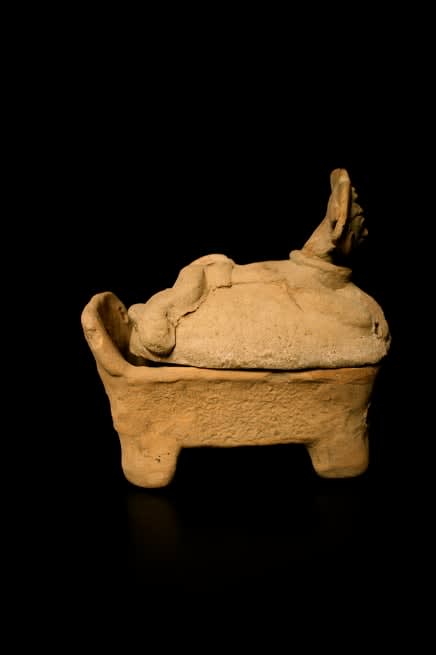Veracruz Vessel with Anthropomorphic Lid, 400 CE - 800 CE
Terracotta
3 x 5.5 x 5.25
DE.049 (LSO)
Further images
This remarkable object is a therianthropic vessel made by under the Veracruz culture, of SE Mexico. The piece is a four-legged ceramic vessel, pierced at both ends with large holes....
This remarkable object is a therianthropic vessel made by under the Veracruz culture, of SE Mexico. The piece is a four-legged ceramic vessel, pierced at both ends with large holes. It is dominated by a masterfully-carved human head, which protrudes from the top of a lid that has been moulded to the likeness of an animal’s body (perhaps that of a jaguar). The head is classically Veracruz, with an ornate asymmetrical headdress, large ear-flares, a rather flat “Chinesco” style face and a studiedly impassive expression. The modelling of facial features and accessories is exceptional. The remainder of the vessel is far more stylised and general in its execution; clearly the head is designed to be the focal point of the piece.
The piece dates from the latter end of the first millennium AD, a dynamic time in Eastern Mexican political and social regimes. The Classic Veracruz cultures were small, tightly-packed city states, all governed by hereditary rulers, who sat at the top of highly stratified social structures. Economically, it was based upon slash and burn agricultural techniques, supplemented by exploitation of marine resources, as well as hunting. The culture was fuelled by long- distance trade networks that ran throughout Mesoamerica, as evidenced by the spread of luxury items and exotic goods. In this they strongly resemble the Olmecs, who preceded them and to whom they owed a considerable cultural and artistic debt.
Religion was based upon the Olmec “earth monster”, as well as a death god who has been likened to Mictlantecuhtli, a deity worshipped by their cultural neighbour, the Aztecs. Like the Aztecs, they were obsessed with death, sacrifice and the Mesoamerican ballgame, another cultural bequest from the Olmecs. There are accounts stating that the losing team was sacrificed as an offering to the gods; other chroniclers suggest that it might have been used as a substitute for warfare. As a result their iconography is somewhat sanguineous – with decapitations, blood-letting and bound prisoners common themes – surrounded by extensive and convoluted banded scrolls that can be seen both on monumental architecture and on mobiliary art. A defining characteristic of the Classic Veracruz culture is the presence of stone ballgame gear: yokes, hachas, and palmas.
This is a highly unusual object. Its function is uncertain, although it does appear to have been a ritual vessel of some sort. It is likely to have originally occupied a place in a shrine. Whatever its purpose, however, it is a striking piece of Mesoamerican art.
The piece dates from the latter end of the first millennium AD, a dynamic time in Eastern Mexican political and social regimes. The Classic Veracruz cultures were small, tightly-packed city states, all governed by hereditary rulers, who sat at the top of highly stratified social structures. Economically, it was based upon slash and burn agricultural techniques, supplemented by exploitation of marine resources, as well as hunting. The culture was fuelled by long- distance trade networks that ran throughout Mesoamerica, as evidenced by the spread of luxury items and exotic goods. In this they strongly resemble the Olmecs, who preceded them and to whom they owed a considerable cultural and artistic debt.
Religion was based upon the Olmec “earth monster”, as well as a death god who has been likened to Mictlantecuhtli, a deity worshipped by their cultural neighbour, the Aztecs. Like the Aztecs, they were obsessed with death, sacrifice and the Mesoamerican ballgame, another cultural bequest from the Olmecs. There are accounts stating that the losing team was sacrificed as an offering to the gods; other chroniclers suggest that it might have been used as a substitute for warfare. As a result their iconography is somewhat sanguineous – with decapitations, blood-letting and bound prisoners common themes – surrounded by extensive and convoluted banded scrolls that can be seen both on monumental architecture and on mobiliary art. A defining characteristic of the Classic Veracruz culture is the presence of stone ballgame gear: yokes, hachas, and palmas.
This is a highly unusual object. Its function is uncertain, although it does appear to have been a ritual vessel of some sort. It is likely to have originally occupied a place in a shrine. Whatever its purpose, however, it is a striking piece of Mesoamerican art.









